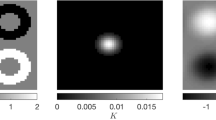Abstract
In the present paper, we discuss and compare several two-step estimation procedures for inhomogeneous shot-noise Cox processes. The intensity function is parametrized by the inhomogeneity parameters while the pair-correlation function is parametrized by the interaction parameters. The suggested procedures are based on a combination of Poisson likelihood estimation of the inhomogeneity parameters in the first step and an adaptation of a method from the homogeneous case for estimation of the interaction parameters in the second step. The adapted methods, based on minimum contrast estimation, composite likelihood and Palm likelihood, are compared both theoretically and by means of a simulation study. The general conclusion from the simulation study is that the three estimation methods have similar performance. Two-step estimation with Palm likelihood has not been considered before and is motivated by the superior performance of the Palm likelihood in the stationary case for estimation of certain parameters of interest. Asymptotic normality of the two-step estimator with Palm likelihood is proved.


Similar content being viewed by others
References
Baddeley, A. J., Turner, R. (2005). Spatstat: An R package for analyzing spatial point patterns. Journal of Statistical Software, 12, 1–42.
Baddeley, A. J., Møller, J., Waagepetersen, R. (2000). Non- and semiparametric estimation of interaction in inhomogeneous point patterns. Statistica Neerlandica, 54, 329–350.
Baddeley, A. J., Rubak, E., Turner, R. (2015). Spatial point patterns: Methodology and applications with R. London: Chapman and Hall/CRC Press.
Chiu, S. N., Stoyan, D., Kendall, W. S., Mecke, J. (2013). Stochastic geometry and its applications (3rd ed.). Chichester: Wiley.
Cox, D. R. (1955). Some statistical models related with series of events. Journal of the Royal Statistical Society: Series B, 17, 129–164.
Daley, D. J., Vere-Jones, D. (2003). An introduction to the theory of point processes. Volume 1: Elementary theory and methods. New York: Springer.
Daley, D. J., Vere-Jones, D. (2008). An introduction to the theory of point processes. Volume 2: General theory and structure. New York: Springer.
Diggle, P. J. (1983). Statistical analysis of spatial point patterns. London: Academic Press.
Diggle, P. J. (2003). Statistical analysis of spatial point patterns (2nd ed.). New York: Oxford University Press.
Dvořák, J., Prokešová, M. (2012). Moment estimation methods for stationary spatial Cox processes—A comparison. Kybernetika, 48, 1007–1026.
Guan, Y. (2006). A composite likelihood approach in fitting spatial point process models. Journal of the American Statistical Association, 101, 1502–1512.
Guan, Y. (2009). A minimum contrast estimation procedure for estimating the second-order parameters of inhomogeneous spatial point processes. Statistics and its Interface, 2, 91–99.
Guan, Y., Sherman, M. (2007). On least squares fitting for stationary spatial point processes. Journal of the Royal Statistical Society: Series B, 69, 31–49.
Guyon, X. (1991). Random fields on a network. New York: Springer.
Hahn, U., Jensen, E. B. V. (2015). Hidden second-order stationary spatial point processes. Scandinavian Journal of Statistics,. doi:10.1111/sjos.12185.
Heinrich, L. (1988). Asymptotic Gaussianity of some estimators for reduced factorial moment measures and product densities of stationary Poisson cluster processes. Statistics, 19, 87–106.
Heinrich, L. (1992). Minimum contrast estimates for parameters of spatial ergodic point processes. In: Transactions of the 11th Prague Conference on Random Processes, Information Theory and Statistical Decision Functions. Prague: Academic Publishing House.
Hellmund, G., Prokešová, M., Jensen, E. B. V. (2008). Lévy-based Cox point processes. Advances in Applied Probability, 40, 603–629.
Illian, J., Penttinen, A., Stoyan, H., Stoyan, D. (2008). Statistical analysis and modelling of spatial point patterns. Chichester: Wiley.
Jalilian, A., Guan, Y., Waagepetersen, R. P. (2013). Decomposition of variance for spatial Cox processes. Scandinavian Journal of Statistics, 40, 119–137.
Lindsay, B. G. (1988). Composite likelihood methods. Contemporary Mathematics, 80, 221–239.
Matérn, B. (1971) Doubly stochastic Poisson processes in the plane. In: Statistical ecology (volume 1). University Park: Pennsylvania State University Press.
Møller, J. (2003). Shot noise Cox processes. Advances in Applied Probability, 35, 614–640.
Møller, J., Waagepetersen, R. P. (2003). Statistical inference and simulation for spatial point processes. Boca Raton: Chapman & Hall/CRC.
Møller, J., Waagepetersen, R. P. (2007). Modern statistics for spatial point processes. Scandinavian Journal of Statistics, 34, 643–684.
Prokešová, M., Dvořák, J. (2014). Statistics for inhomogeneous space-time shot-noise Cox processes. Methodology and Computing in Applied Probability, 16, 433–449.
Prokešová, M., Jensen, E. B. V. (2013). Asymptotic Palm likelihood theory for stationary point processes. Annals of the Institute of Statistical Mathematics, 65, 387–412.
Tanaka, U., Ogata, Y., Stoyan, D. (2007). Parameter estimation and model selection for Neyman–Scott point processes. Biometrical Journal, 49, 1–15.
Thomas, M. (1949). A generalization of Poisson’s binomial limit for use in ecology. Biometrika, 36, 18–25.
Waagepetersen, R. P. (2007). An estimating function approach to inference for inhomogeneous Neyman–Scott processes. Biometrics, 63, 252–258.
Waagepetersen, R. P., Guan, Y. (2009). Two-step estimation for inhomogeneous spatial point processes. Journal of the Royal Statistical Society: Series B, 71, 685–702.
Acknowledgments
This project has been supported by the Czech Science Foundation, Project No. P201/10/0472, Charles University Grant Agency, Project No. 664313, and by Centre for Stochastic Geometry and Advanced Bioimaging, funded by a Grant from The Villum Foundation. We thank the referees for constructive comments and suggestions both concerning the content and exposition of the paper.
Author information
Authors and Affiliations
Corresponding author
About this article
Cite this article
Prokešová, M., Dvořák, J. & Jensen, E.B.V. Two-step estimation procedures for inhomogeneous shot-noise Cox processes. Ann Inst Stat Math 69, 513–542 (2017). https://doi.org/10.1007/s10463-016-0556-y
Received:
Revised:
Published:
Issue Date:
DOI: https://doi.org/10.1007/s10463-016-0556-y




